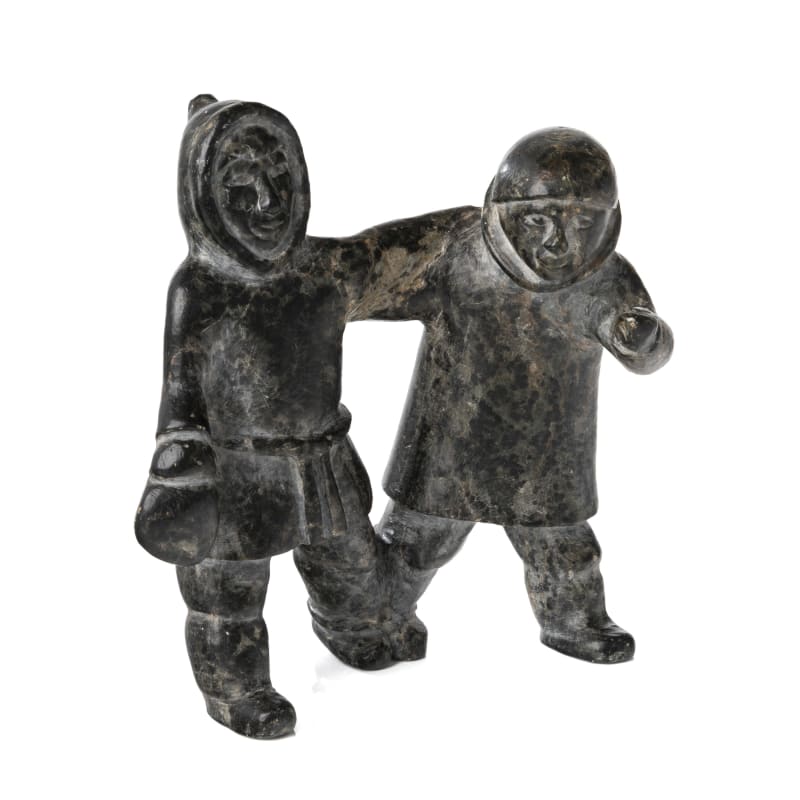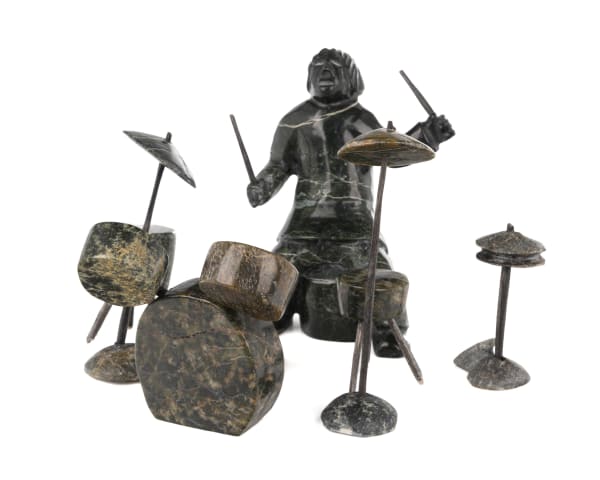ESOTERIC
/ˌɛsəˈtɛrɪk/.
adjective
very unusual and understood or liked by only a small number of people, especially those with special knowledge.
On my first visit to John and Joyce’s home, I felt like a kid in a proverbial candy store. I found myself in the presence of what I and some friends of mine would call “celebrity works” of Indigenous art [1]. There was an exhilaration that bubbled up inside me as I laid eyes on the Migration Boat of Joe owls that I had only read about before. Not only was I seeing it in flesh but I had the pleasure of sharing wine and cherries with the famed “Seattle collector” and his “knitting wife” [2]. I recognized dozens of other works I had seen in authoritative volumes like Sculpture/Inuit, “Swinton,” and other tomes of Inuit Art.
The collection also housed a breathtaking array of virtually every art form from the Pacific Northwest and, crucially, other great works from beyond the treeline. I found myself amongst a rain forest of hat stands, where an almost three-foot Heiltsuk or Haisla snouted creature, with its articulated jaw, was tucked neatly amongst finely woven rain hats. And then there was the striking Jim Schoppert work, greeting me with a toothy grin as I stepped into the living room, as if he were holding court amongst other treasures.
I’m only a little embarrassed to admit that when the works selected for the first sale arrived back in Toronto, and I found myself alone on a quiet Saturday morning, unpacking, I let myself really commune with these objects. I know this sounds a little syrupy but at that moment, I thought of my twenty-two-year-old self, fresh out of school and starting in the art world. If she could see us now: gently petting the nose of the little pup in Kenojuak’s Family with Dog — a work I had seen in pictures when it showed at the Pushkin in Russia — she wouldn’t believe it. I allowed myself a polite little happy cry, letting the emotions of the journey wash over me.
It wasn’t until my second visit to the Price home that I was able to truly grasp the depth and breadth of John and Joyce’s collection.
Anyone who knows me understands my fascination with the unusual and art that is off the beaten path. This is not to diminish the beauty and significance of more commonly seen subjects in Indigenous art—after all, I am the proud owner of muskoxen sculptures and polar bear carvings. But in my home, these traditional works coexist with more peculiar scenes: an anthropomorphic fork and spoon locked in battle by Padloo Samayualie; a dancing couple by a lesser-known Pannirtuq artist, depicting two kabloona in mid-dance; and Pits Qimirpik’s small sculpture On the Chair, an explicit depiction of intimacy that leaves absolutely nothing to the imagination.
On this second visit, we still had wine and cherries, but it was the unique and unusual works that captivated me, scratching an itch in my brain that revels in the offbeat and the unexpected.
As I looked through the collection on this visit, I still felt a sense of exhilaration—not from being star-struck, but from the reminder of what I love about all art: its power to surprise and provoke, offering glimpses into worlds both familiar and fantastically strange. These a-typical works reflect the diversity and complexity of Indigenous art, providing insight into the myriad of ways in which artists interpret and express their identities and experiences.
The diversity of this exhibition is a small testament to the full spectrum of Indigenous artistic expression and we at First Arts are pleased to share a sampling of some of these esoteric works. In offering these works, we hope that they find admiring new homes for like-minded individuals, where their unexpected nature will continue to surprise and inspire. It is my hope that, in seeing these artworks and remembering the other “celebrity works” in the Price Collection, it will serve as a reminder that Indigenous art is not a monolith but a vibrant continuum that has always thrived on diversity and innovation.
Nadine Di Monte
1. I think it was Emily Lawrence, editor at the Inuit Art Foundation who coined the term.
2. I cannot put my hands on the article so the exact origins remain a mystery but Joyce thinks it may have been in the Toronto Sun
Works may be viewed by appointment only at One William Morgan Drive in Toronto.
To obtain condition reports and additional images, please contact info@firstarts.ca or 647-286-5012.
On View;Tuesday 17 September - Monday 7 October 2024 by appointment only |
LOCATIONOne William Morgan Drive Toronto, Ontario M4H 1N6 |
-

2
UNIDENTIFIED ARTIST, KUGLUKTUK (COPPERMINE)
Judge John Howard Sissons at his Desk, with the Stuffed Duck, c. 1966
stone, metal pin, and red pigment, 6.25 x 12.74 x 6.75 in (15.9 x 32.4 x 17.1 cm)
-

3
PITSEOLAK QIMIRPIK (1986-) KINNGAIT (CAPE DORSET)
Drummer, 2000s
stone and wood, dimensions variable, the figure: 4.75 x 3.5 x 3.25 in (12.1 x 8.9 x 8.3 cm)
-

Lot 4
JAMASEE PITSEOLAK (1968-) KINNGAIT (CAPE DORSET)
Servicing an Outboard Motor on a Barrel, 2000s
stone and antler, 4.25 x 3.5 x 3 in (10.8 x 8.9 x 7.6 cm)
-

5
ROBIN RORICK (1980-) HAIDA, OLD MASSET, HAIDA GWAII
Longbard with Mosquito Design, 2018
longboard and pigment, 44 x 9.25 x 1.5 in (111.8 x 23.5 x 3.8 cm).
-

6
JOE TALIRUNILI (1893-1976) PUVIRNITUQ (POVUNGNITUK)
Three Legged Race, mid-late 1960s
stone, 6.75 x 6.25 x 4 in (17.1 x 15.9 x 10.2 cm)
-

8
NAPACHIE SHARKY (1971-) KINNGAIT (CAPE DORSET)
Bucked from the Snow Machine, 2000s
stone, 2 x 5 x 2.75 in (5.1 x 12.7 x 7 cm)
-

10
UNIDENTIFIED NUU-CHAH-NULTH or MAKAH ARTIST
Geometric Design Basketry Woven Abalone Shell, 1920s
abalone shell, natural and dyed bear grass, cedar root, 1.5 x 4.75 x 3.75 in (3.8 x 12.1 x 9.5 cm)
-

12
MRS. BILL (20th C), NUU-CHAH-NULTH, PORT ALBERNI, B.C.
Pictorial Basketry Woven Abalone Shell with Whaling Scene, 1920s
abalone shell, natural and dyed bear grass, 2 x 5.75 x 4 in (5.1 x 14.6 x 10.2 cm)











